#GianLorenzo Bernini
Photo
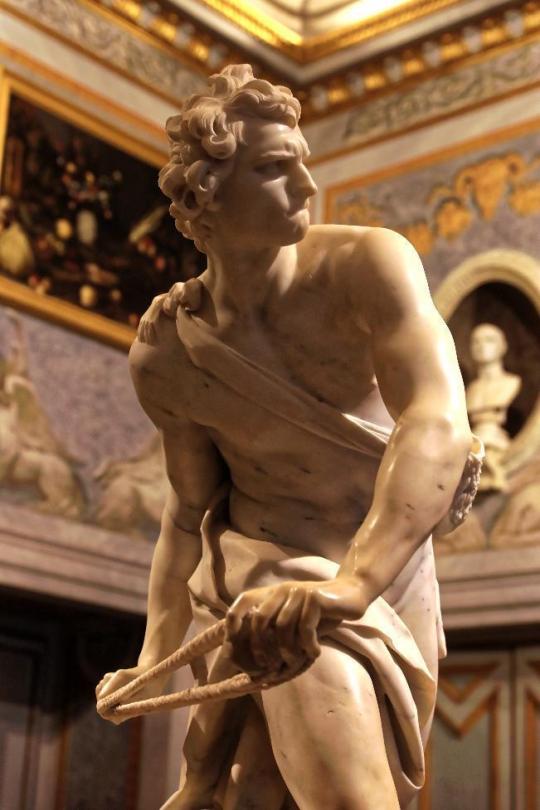
MWW Artwork of the Day (5/10/23)
Gianlorenzo Bernini (Italian, 1598-1680)
David (c. 1623-24)
Carrara marble statue, 170 cm. high
Galleria Borghese, Rome
When he tackled his David in 1623-24, Bernini knew that he was risking comparison with works in a sculptural tradition that included the great names of the artistic culture of the Italian Renaissance, from Donatello to Verrocchio and Michelangelo. He subverted the traditional way of representing David. Instead of depicting the static figure after killing Goliath (as had Donatello and Verrocchio) or the measured strain of the act itself (as had Michelangelo), Bernini once again countered with the dynamic charge of the spiral. It is well known that he took his inspiration from the so-called Borghese Gladiator, now in the Louvre but at the time one of the prize pieces in Cardinal Borghese's collection. From the Gladiator derive the feet planted widely apart and the twisting torso.
For more of Bernini's work, see this MWW Special Collection:
https://www.facebook.com/media/set/?vanity=TheMuseumWithoutWalls&set=a.371960352909340
18 notes
·
View notes
Text
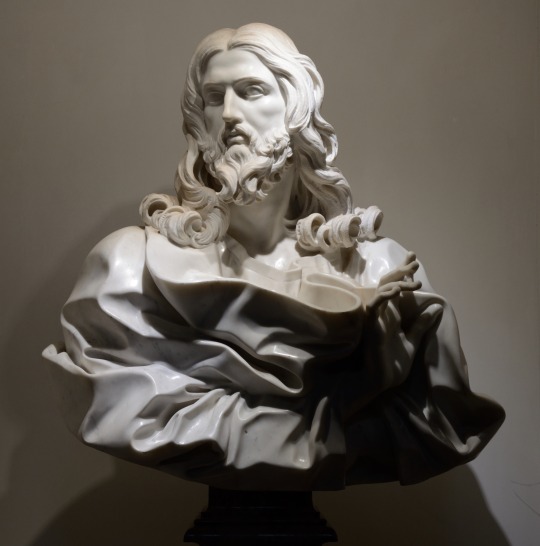
Bust of the Saviour (Salvator Mundi)
(Bust of Jesus Christ)
Sculpture by Gianlorenzo Bernini
marble and jasper, 1680
#Gianlorenzo Bernini#art#artist#sculptor#sculpture#marble and jasper#1680#Sculpture by Gianlorenzo Bernini#Bust of the Saviour (Salvator Mundi)#Bernini
86 notes
·
View notes
Photo

sculpture by gianlorenzo bernini
10 notes
·
View notes
Photo

Roma. Santa Maria del Popolo. Altar del crucero de la Epístola, diseño de Gianlorenzo Bernini. - Gian Lorenzo Bernini
8 notes
·
View notes
Text
Twa miłość zawieść nas nie może...
Twa miłość zawieść nas nie może…
Twa miłość zawieść nas nie może…Twa miłość zawieść nas nie może, błogosław nas Boże – słowa tej piosenki chodzą za mną dziś od rana.Cudowny tekst. Czasem każdemu z nas tak się czasem zdarza, że usłyszy jakiś tekst i wydaje się, że drąży w nas i zastanawiamy się nad sensem a czasem nam po prostu w duszy gra, chociaż może to echo gra – jak pisał nasz wielki mistrz mowy polskiej, romantyk Adam. Echo…

View On WordPress
4 notes
·
View notes
Text


The Ectasy of Saint Teresa, Gianlorenzo Bernini, 1647-52
#art history#art#17th century#baroque#baroque art#saint teresa#dark academia#aesthethic#gian lorenzo bernini#rome#santa maria della vittoria#bernini#religious art#italian art#catholic aesthetic
161 notes
·
View notes
Text

Mastermind of the Baroque, Gianlorenzo Bernini.
217 notes
·
View notes
Text

Gianlorenzo Bernini: Ares Ludovisi
123 notes
·
View notes
Text

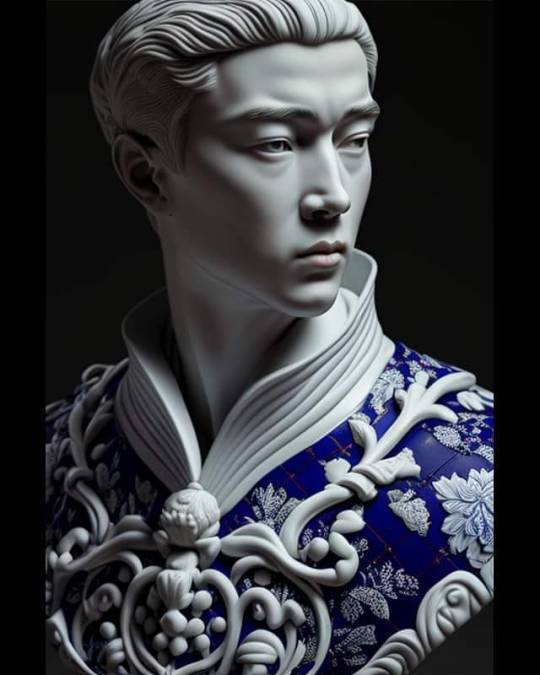


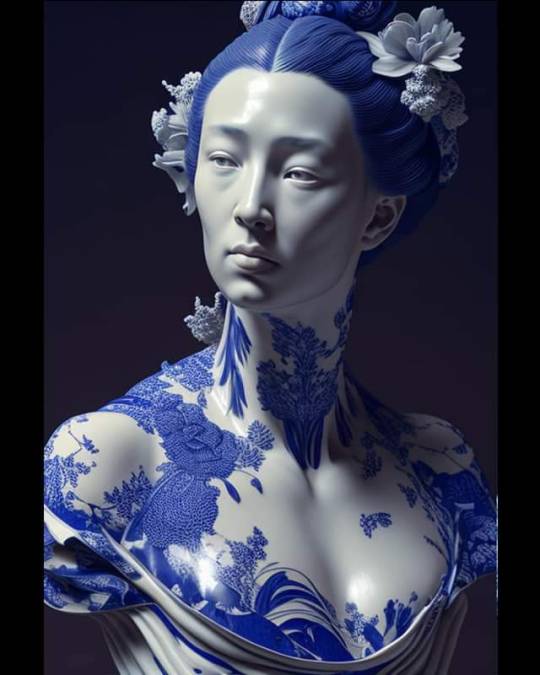
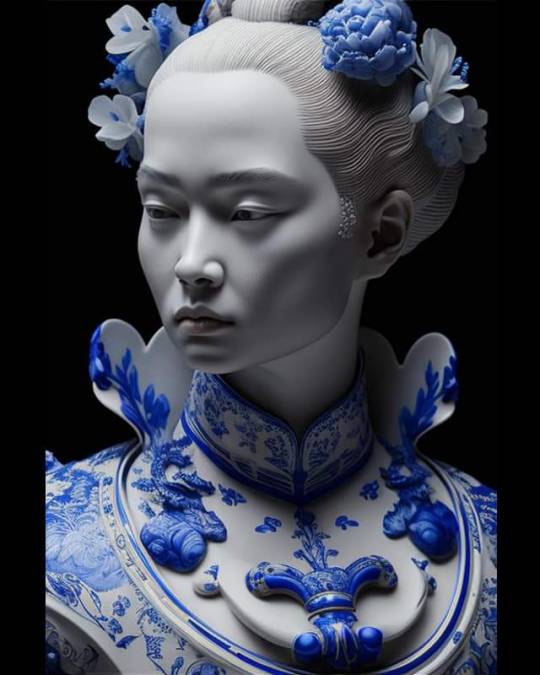
A mediados del 1700 el erudito, calígrafo, astrónomo y farmacólogo chino Xu Hongjing viajó a Europa para conocer al escultor Francesco Queirolo (1704 - 1762) y aprender de éste el "ars regia". Se cree que el italiano no era otro que el mismísimo Gianlorenzo Bernini (1598 - 1680), el cual tras fingir su muerte habría cambiado varias veces de identidad (se cree que trabajó bajo los nombres de Lorenzo Mattielli y Antonio Corradi, cuyos estilos son muy similares, por no decir idénticos). La sobrenatural longevidad del escultor se debería a que este era un eximio alquimista entre cuyos logros estaba el de haber alcanzado la elaboración del secreto elixir conocido como piedra filosofal, además de una receta para ablandar el mármol a partir de una hierba llamada Planta Cabrera, lo cual le hubo permitido alcanzar la maravillosa y cuantiosa manufactura escultórica por la cual se le conoce. Hayan sido o no Bernini y Queirolo la misma persona, lo cierto es que el resultado del paso de Hongjing por el viejo continente quedó plasmado en esta exquisita serie de bustos de porcelana.
22 notes
·
View notes
Text

Sculpture by Adolfo Apolloni (Rome,1 March 1855 - Rome, 19 October 1923) at The Staglieno Cemetery, Genoa - Italy.
Burial monument of the CALCAGNO Family
Winged feminine figure. 1904
After having studied at the 'Accademia di San Luca', Apolloni moved in 1879 to Boston, where he taught sculpture and drawing at the Conservatory of Music. Later he moved to Providence (Rhode Island), where he met and married his wife, Martha, in 1883.
From 1900 to 1922, he attended the Royal School of art applied to industry of Fano (which after his death was named after him). He was also Mayor of Rome from June 1919 to November 1920.
In 1919 he made a copy in Travertine of the Fountain of the Bees of Gianlorenzo Bernini, now located at the entrance of Via Veneto.
#Adolfo Apolloni#sculpture#Winged Feminine Figure#1904#Burial monument of the CALCAGNO Family#The Staglieno Cemetery#Genoa#Italy#What is Remembered Lives#Ancestors Alive!#art for art's sake
9 notes
·
View notes
Text
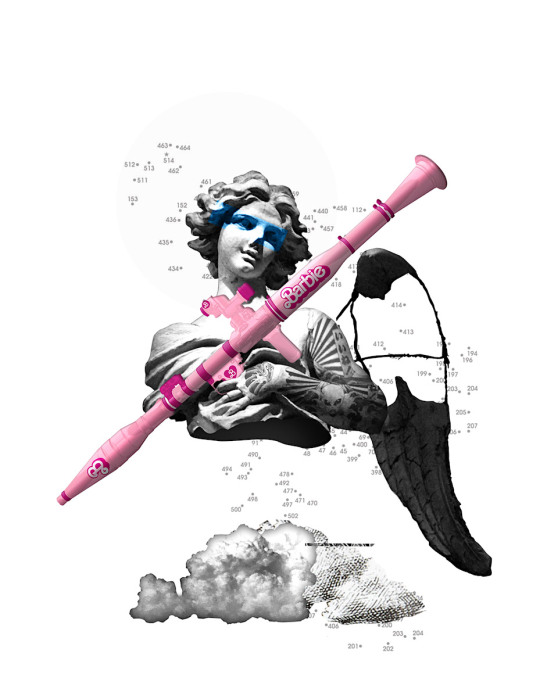
eucanthos
elemental traces no.9 ∈ 42 / meta-avenger
Gianlorenzo Bernini: Angel model for St Peter's Cathedra, ca. 1560
Magnus Gjoen: Barbie stars n stripes launcher (bazooka), 2023
Sohei Otomo: Ninja girl back
https://commons.wikimedia.org/wiki/Category:Models_for_Saint_Peter_Chair_by_Gian_Lorenzo_Bernini_(Vatican_Museum,_Pinacoteca)
https://www.magnusgjoen.com/product-page/barbie-stars-n-stripes-laucher
28 aug update
#eucanthos#collage#appropriation#angel#Gianlorenzo Bernini#cut#Magnus Gjoen#gun#pink#barbie#plastic#42
9 notes
·
View notes
Photo

MWW Artwork of the Day (11/2/22)
Gianlorenzo Bernini (Italian, 1598-1680)
Neptune and Triton (c. 1620-23)
Marble sculpture, 182.2 cm. high
Victoria & Albert Museum, London
Bernini’s "Neptune and Triton" references the mythological characters of Neptune (or Poseidon) and his son Triton, the rulers of the seas. Bernini’s sculpture gives a slightly different representation of the duo. In Bernini’s sculpture, you see Neptune towering over Triton. He appears to be a man in his early thirties, with a beard and wavy locks. Neptune has his legs spread apart and is balancing on a large seashell that carries both himself and Triton. Neptune only has a large sheet covering his right shoulder and gliding in between his legs, revealing parts of the male anatomy. The anatomy of the entire body is defined and the twisting of his torso gives him a more trimmed outline of his muscles, allowing the viewer to pay particular attention to his muscles and how they are contracted or relaxed in his state of movement.
For a representative selection of Bernini's work, see this MWW Special Collection:
https://www.facebook.com/media/set/?vanity=TheMuseumWithoutWalls&set=a.371960352909340
3 notes
·
View notes
Text
Perhaps Bernini’s “secret” will now have become clear. Upon the illusion normally expected in the theater he superimposed another illusion that was unexpected, and in which the audience was directly involved. The spectator, in an instant, became an actor, conscious of himself as an active, if disconcerted, participant in the “happening.” The crucial thing is that when he returned to his ordinary level of existence he became aware that someone had created this response.
The relevance of this awareness lies in a series of interlocking conceits which link the theater and art on a level that can only be described as metaphysical. It has repeatedly been observed that in the long and continuous history of metaphors relating the theater on the one hand to real life and on the other to abstract ideas, the early seventeenth century was of special importance. A growing sense of the reality of the stage seems to have converged with a growing sense of the illusoriness of reality, to produce a paradoxical equation of the two. The equation became a leading topos of the period — in its most encompassing form as the theatrum mundi, or theater of the world, whose “producer” is God; in its most concrete and circumscribed form, as the play-within-the-play.
Visible Spirit: The Art of Gianlorenzo Bernini, Vol. 1, Irving Lavin, 2007.
17 notes
·
View notes
Note
Would you like to share your thoughts on the bokuakakuroken dynamic?
OKAY so uhh it took me longer to get to this than anticipated. unfortunately i got this ask RIGHT before i started my shift, and its been ough, more than 12 hours since i ended my shift, which means my thoughts had so much time to change and morph
i will try to gather my thoughts into coherency fjakjbas (no promises tho,,), these arent all necessarily romantic, i think they CAN be! but i think if they are a polycule, theyre a friendgroup first?? idk, i think they are a mix of romantic, queerplatonic, friendship soup yknow??
but i really enjoy the subtle rivalry between akaashi and kenma on the court. It's not the overt goading and gloating that bokuto and kuro have with each other, but its there. And I adore it. Captains and setters mirroring each other... balance... in my brain. I think there is lots of team work OFF the court between kenma and akaashi too, especially when it comes to making fun of bokuto and kuroo. they have an understanding
i think bokuto and kenma are an interesting pair. in volleyball, bokuto is WAY TOO MUCH for kenma. he's loud and boisterous and greedy. he's like shouyou, kenma can't get away with anything. off the court, bokuto is STILL A LOT, but he also shows such *genuine* interest in kenma's interests, he's attentive and engaged. he also gets *way less* scandalized by nudity and gore in Kenma's more intense games. Kenma isnt great at explaining things, but bokutos go gettem attitude makes him a pretty fun player two
kuroo and akaashi... i thought about them a lot. to me, they are STEM and HUMANITIES solidarity. I'm going to tangent to curate the vibe~~.
The separation of stem and humanities is a fairly recent development in education/academia. in the european renaissance, art and science were so deeply interconnected. to be an artist you had to understand the natural world. it helped you greatly as a scientist if you could depict the world you saw. Leonardo da Vinci probably comes to mind, incredible artist and inventor. He stared at water for hours watching it ripple. He believed that if you were not outside drawing every second you could, you were hardly an artist at all (he was VERY hardcore, and VERY uhh.. most ppl didnt like him much. Same with michelangelo. Raphael was the renaissance's golden boy, it's why the pope was in close contact with him while he did the school of athens in his library while michelangelo was still waiting for a letter back from the pope about the sistine chapel (pope didnt wanna talk to him) none of this is relevant but i LOVE talking about this stuff. Bernini is my favorite, though he is Baroque/late renaissance rather than High Renaissance (after the mannerist movement!! very important distinction. (did you know there were TWO bernini's? Gianlorenzo's father, pietro would have been more famous if his son wasn't a prodigy. but he wasn't resentful, he ate up his son's skill, was very proud "i will be known as the father an mentor of the great gianlorenzo!" cute stuff) what number of parenthesis am i at? i think this is the last one)
i digress. I think of akaashi, a literature nerd, and kuroo, a science nerd. and I think of them appreciating that about each other. I like to think that if one of them has intense, burning thoughts about something that moves them, a passage written so beautifully, a chemical reaction so moving, they share with each other. both of them i think, share a certain appreciation for the beauty in the world, and can really appreciate the beauty that the other's perspective comes from. they bleed into each other, akaashi starts thinking more of the physical world, and kuroo, already a metaphorical savant (we are blood, anyone?) appreciates akaashi's musing (absolutely LAUGHED at him the first time Akaashi waxed poetic about bokuto though. They have solidarity but they still lowkey antagonize each other aksfjbaksjfbaskjfbakj)
i think ill cut my thoughts off here. ive really rambled and i think most of it wasn't STRICTLY about bokuakakuroken, but when i was thinking about them yesterday, this.. kinda was the deal. my thoughts can be really difficult to capture and tie down, theyre amorphous clouds that twist and change in hurricane winds so sometimes they just come out as "WAAHA CRYING SOBBINGS OUGH" because thats the only way i can get them out before they slip away
im supposed to be writing things down more, it helps me a lot. but, if you were interested in maybe a sneak peak of what its like to try to think of a single topic in my brain,,, here u go! please enjoy the content you asked for, and i hope the content you DIDNT ask for was at least a little bit interesting <3
#conspiracy lvl: ask#i will not put this in the tags#since its a fucking mess asbfjkajfbaksjfa#art musings#i just...really wanted to talk about it#long post
4 notes
·
View notes
Text
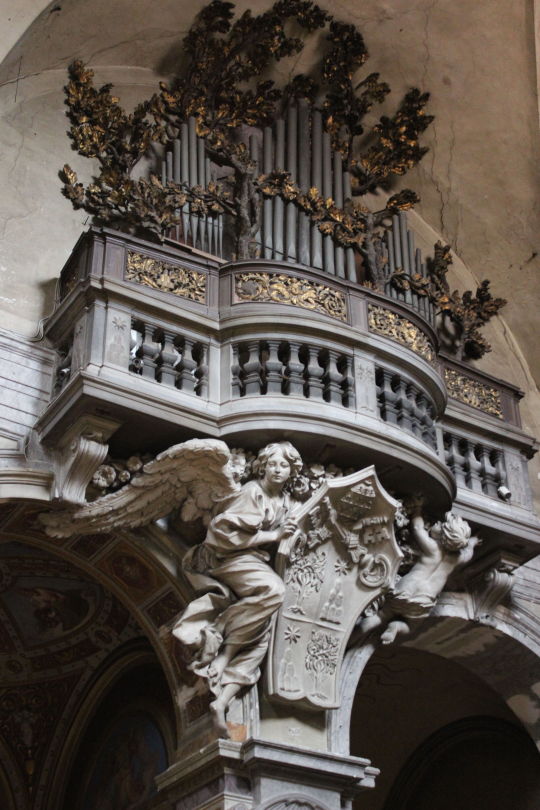
Gian Lorenzo Bernini - Roma. Santa Maria del Popolo. Órgano del lado de la Epístola, con diseño de Gianlorenzo Bernini.
11 notes
·
View notes
Text
Nieskończona, najśliczniejsza miłości...
Nieskończona, najśliczniejsza, Jezu miłości! – to cudowna pieśń, która słyszałam wczoraj po raz drugi. Pierwszy raz słyszałam ją w Sanktuarium w Kalwarii Zebrzydowskiej kiedy byłam tam ostatnio i od tej pory ciągle ta melodia oraz słowa nie tyle za za mną chodziły, co raczej brzmiały mi gdzieś za uchem lekką rzewną nutą. Zupełnie nie wiem jak to możliwe, że wcześniej jej nigdy nie…
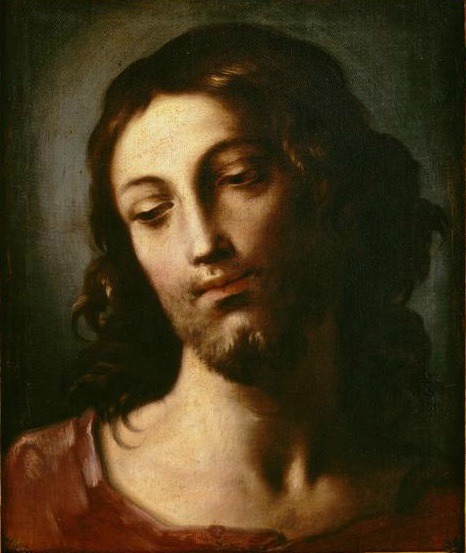
View On WordPress
#Elisabetta Sirani#GianLorenzo Bernini#Jezus Chrystus#Michał Anioł Buonarroti#Micheleangelo Buonarroti Simoni#Salvator Mundi
1 note
·
View note